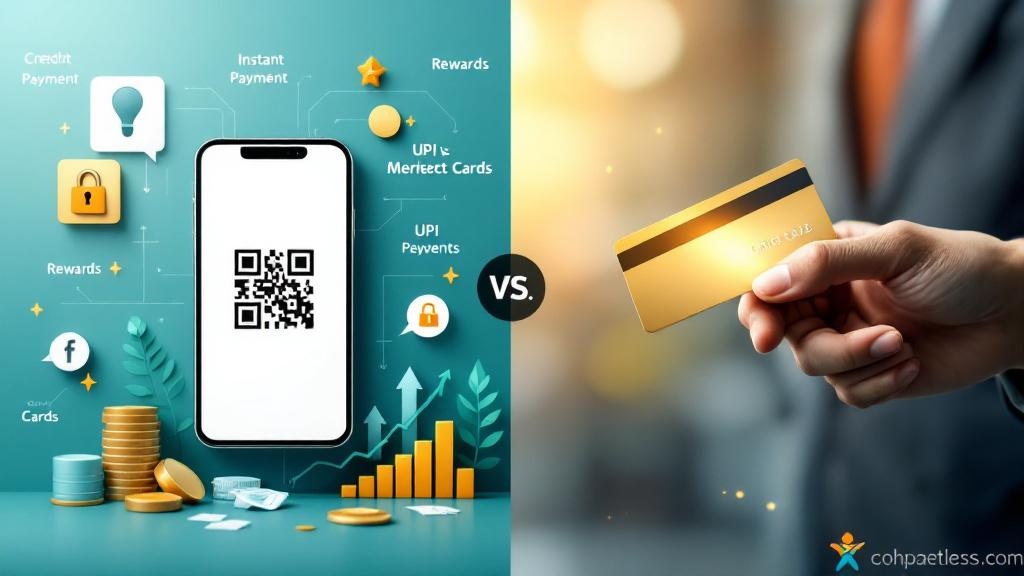Explore the UPI vs credit cards debate in India. Learn about the benefits, limitations, and trends of UPI vs credit cards in 2025. Compare credit card fees, UPI advantages, and the future of digital payments.
Introduction: UPI vs Credit Cards – A Digital Payment Revolution in India
India’s digital payment ecosystem has evolved rapidly over the past decade. Among the various payment methods, UPI (Unified Payments Interface) and credit cards are two dominant players. But as the nation marches toward cashless transactions, the debate about which is the best payment method continues to grow.
In this article, we’ll dive into a detailed comparison of UPI vs credit cards in India, highlighting their pros and cons, growth trends, and what makes them stand out as payment methods in the digital age. By the end of this blog, you’ll have a clear understanding of which method is more suited to your needs, based on convenience, fees, and security.
UPI vs Credit Cards in India: The Basics
Before diving into the comparison, let’s establish the core functions of UPI and credit cards.
UPI (Unified Payments Interface): A real-time, bank-to-bank money transfer platform launched by the National Payments Corporation of India (NPCI). UPI has become a game-changer in India’s digital payment landscape, enabling instant transactions with just a mobile number or QR code.
Credit Cards: A plastic card issued by financial institutions, allowing users to borrow funds to make purchases or withdraw cash, with the expectation of paying back later, typically with interest.
Both have their unique advantages, but their suitability varies depending on the user’s needs.
UPI Growth in India: The Transformation of Digital Payments
What Makes UPI So Popular?
Since its launch in 2016, UPI has grown exponentially, becoming the best payment method in India 2025. A few reasons for its rapid adoption include:
Ease of Use: UPI enables users to transfer money instantly using their mobile phones, with no need for physical cards or even internet banking credentials.
Low Transaction Costs: Unlike credit cards, which often have processing fees and interest charges, UPI transactions are typically free or come with minimal charges, making it a cost-effective option.
Government Backing: UPI enjoys strong support from the Indian government, who aim to promote a cashless society and reduce reliance on physical money.
Security: UPI transactions are secured using two-factor authentication, adding an extra layer of protection. This makes it one of the most secure payment methods in India.
UPI Daily Transaction Limit
One of the major concerns users face when opting for UPI is the daily transaction limit. As of 2025, the transaction limit for UPI is generally around ₹1 lakh per day. While this is sufficient for most day-to-day transactions, it can become a limitation for larger payments.
Credit Card Usage Trends in India
While UPI has taken the lead in terms of daily transactions, credit card usage has not slowed down. In fact, it continues to grow as consumers appreciate the benefits associated with credit card usage.
Credit Card Benefits Over UPI
Credit Facilities: Unlike UPI, where transactions are directly debited from your bank account, credit cards offer a buy now, pay later feature, which can be useful for managing cash flow.
Credit Card Rewards vs UPI Cashback: Credit cards often come with reward points, cashback, and special offers, which are a significant draw for consumers. In comparison, UPI cashback schemes are limited but are still growing.
Widely Accepted for Large Purchases: Credit cards are often the preferred method for large online shopping purchases and international transactions due to their global acceptance and credit limits.
Credit Card Fees in India
While credit cards come with benefits, they also have their drawbacks. Some of the main fees associated with credit cards include:
Annual Fees: Most credit cards charge annual maintenance fees, ranging from ₹500 to ₹5,000, depending on the card type and the bank offering it.
Interest Rates: Credit cards often carry high interest rates (between 12% and 36%) if the outstanding balance is not paid off in full each month.
Late Payment Fees: Missing payments can result in hefty fees and a negative impact on your credit score.
The Growing Trend of QR Code Payments
Both UPI and credit cards are leaning towards QR code payments for convenience. Whether it’s using the BHIM app or a credit card-linked payment app, QR codes are an increasingly common way to make transactions in both online and offline retail environments.
Digital Payments Comparison in India: UPI vs Credit Cards
Let’s take a closer look at how UPI compares with credit cards on the following parameters:
| Parameter | UPI | Credit Cards |
|---|---|---|
| Transaction Speed | Instant payments (real-time transfer) | Payments are not instant, especially if payment is made in installments. |
| Transaction Fees | Minimal or no fees | High processing fees (typically 1-2%) + interest if balance is carried forward. |
| Security | High security with two-factor authentication | Secured with pin and OTP but susceptible to fraud if card details are compromised. |
| Rewards/Benefits | Limited cashback and rewards | Reward points, cashback, travel benefits, and exclusive offers. |
| Best for | Small daily transactions, peer-to-peer payments, bill payments | Large purchases, emergency credit, and managing cash flow. |
| User Limitations | ₹1 lakh daily transaction limit | High annual fees and interest rates. |
UPI vs Credit Cards: The Future of Digital Payments in India
In 2025, both UPI and credit cards will continue to play a significant role in the Indian payment landscape. However, with the rise of fintech adoption in India, the cashless payment systems are becoming more sophisticated, leading to enhanced consumer choices.
The ongoing battle between UPI vs credit cards will also evolve based on:
Consumer Preferences: As more Indians opt for digital payments, their preferences will shape the growth of both UPI and credit card usage.
Government and RBI Policies: Changes in policies, such as the credit score impact in India or updated payment gateway regulations, could influence usage patterns.
Fintech Innovation: The rise of payment apps, wallets, and even instant bank transfer India options will further disrupt the market.
Frequently Asked Questions (FAQs)
1. What is better: UPI or credit cards in India?
It depends on your needs. If you prefer instant payments without fees, UPI is a great option. However, if you need credit facilities and rewards, credit cards might suit you better.
2. What are the advantages and disadvantages of UPI?
Advantages: Instant payments, no transaction fees, secure, easy to use.
Disadvantages: Daily transaction limit, limited rewards.
3. Are credit cards still relevant in India in 2025?
Yes, credit cards continue to offer benefits like rewards, flexibility in payments, and acceptance for large purchases. However, UPI is gaining ground due to its convenience.
4. What is the best payment method in India in 2025?
Both UPI and credit cards are widely used, but UPI is gaining traction due to its ease of use, security, and zero transaction fees.
5. How does UPI compare to credit cards in terms of security?
UPI transactions are secured using two-factor authentication, making them highly secure. Credit cards are also secured but can be more vulnerable to fraud if details are compromised.
6. What is the impact of credit score on credit card usage in India?
Using a credit card responsibly and making timely payments can positively impact your credit score in India, leading to better offers and higher credit limits.
7. How do QR code payments work with UPI and credit cards?
QR code payments enable users to make instant payments by scanning a QR code linked to their UPI account or credit card. It’s a popular method for both online and offline transactions.
Conclusion: Which Payment Method is Right for You?
In conclusion, the choice between UPI vs credit cards in India comes down to your financial habits and preferences. If you’re someone who values instant payments with minimal fees, UPI is likely the better choice. However, if you want rewards, credit facilities, and the flexibility to make larger purchases, credit cards might be the way to go.
Both methods will continue to shape the future of digital payments in India, with a steady trend toward cashless systems. So, whether you’re making a small payment at the local grocery store or buying a new smartphone online, understanding the strengths of each payment option will help you make the best choice for your financial needs.
Tags: UPI vs credit cards, digital payments comparison India, best payment method in India 2025, UPI advantages and disadvantages, credit card benefits over UPI, secure payment options in India








Comments (0)